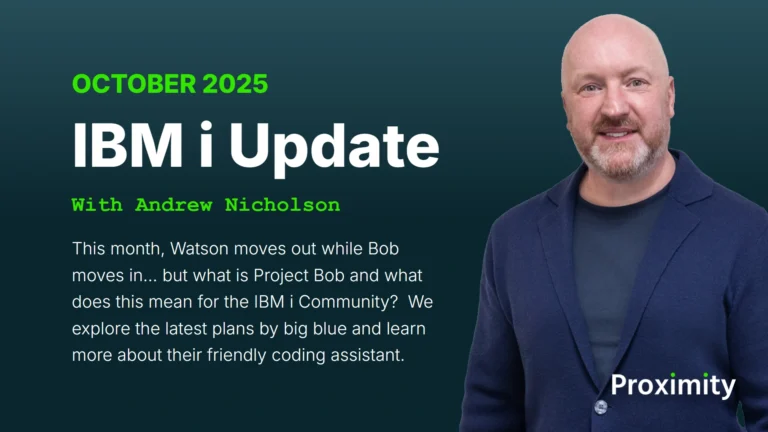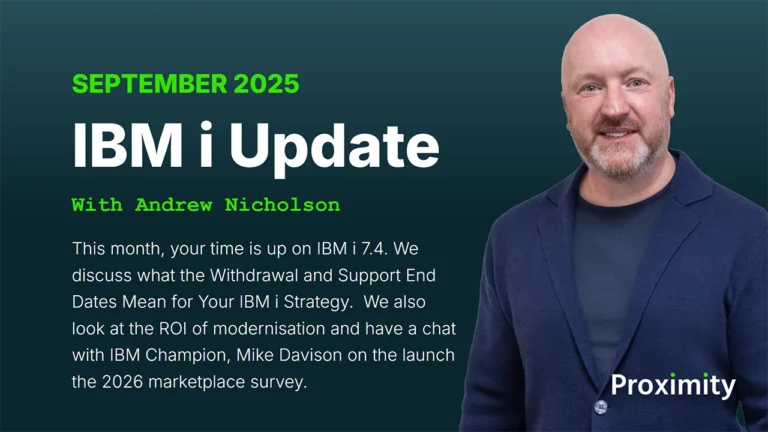You’re responsible for maintaining and supporting business-critical applications on IBM i for your business.
You’ve managed the IBM i and legacy applications for years with absolutely no problems.
But now senior management have announced a move to cloud-based computing.
A familiar scenario?
Here, we examine…
What are your first steps for making your IBM i cloud-based?
The first question you need to ask is:
What do you mean by cloud-based?
Cloud-based can mean a lot of different things.
It might be anything from software as a service (SaaS), to Infrastructure as a service (IaaS).
What is Software as a Service?
With a SaaS model, infrastructure is not your responsibility at all, and you’re consuming it purely as a service.
It’s relatively uncommon to have that as a goal in large corporate IT departments.
If you’ve got an internal IBM i and you’ve got heavily customised applications, then the only way to go to that full-service cloud model is to migrate to a whole new application.
A full migration to a SaaS model is typically expensive and time-consuming, especially for enterprise organisations running business-specific, business-critical legacy applications on IBM i.
Usually, a complete migration to a SaaS model isn’t what senior management means by “moving to the cloud.”
Which brings us very neatly onto IaaS..
What is Infrastructure as a Service?
Often in enterprise IT departments, “I want to go cloud-based” actually means “I want my infrastructure to be in the cloud.”
Typically IaaS means moving infrastructure to a cloud service like Amazon Web Services, Microsoft Azure, Google Cloud, or another specialist IBM i cloud provider (more on that a touch later).
As an IBM i company, that’s actually, both, quite achievable and cost-effective.
IaaS is a much more common approach for IBM i based businesses.
There isn’t the same level of choice for IBM i as there is for Microsoft or Unix based applications, but there are some providers out there for the IBM i Infrastructure as a Service model.
IBM i as a service
A number of providers offer IaaS IBM i as a service, including IBM themselves, SkyTap and Microsoft Azure.
Additionally, more local, UK based companies can provide IBM i as a service, like Bluechip, CSI, and Applied Technologies.
Then, of course, there’s also Abacus, which was recently acquired by our partner Fresche Solutions.
Cloud IBM i for Disaster Recovery
You don’t have to go all-in on cloud immediately.
A cloud server can be your disaster recovery server for example.
In fact, using cloud for disaster recovery can be a very effective first step into cloud for infrastructure.
You can have a cloud server running at a low level that you can then ramp up to cope with a full production workload in the event of disaster recovery needed. Just paying for what you need.
You can also use IBM i cloud server as a test server, or for short term transfer while you’re doing maintenance on your production server.
You can run a disaster recovery server with low levels of power (and therefore very economically) while it’s just receiving information and keeping up to date, and then turn up the power as and when needed.
Stream, our logistics, fleet maintenance & transport management software developed on IBM i, does exactly this.
The core infrastructure is hosted in a UK-based data centre and the backup disaster recovery is fully cloud-based.
IBM i application support as a service
To complete the as-a-service connotations for IBM i, you can also go one step further and work with an IBM i specialist like ourselves who can provide maintenance, support and development services for your IBM i applications.
Just a thought…
—
So when your IT Director or Senior Management says “everything’s got to be cloud”, you can say “yes! You can have your IBM i server in the cloud.”
Schedule your discovery workshop with our IBM i solutions specialist, Andy Nicholson.





